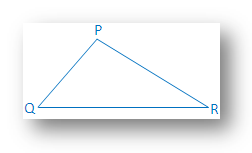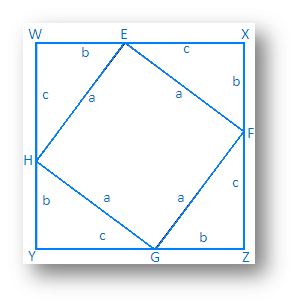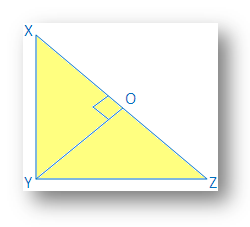Subscribe to our ▶️ YouTube channel 🔴 for the latest videos, updates, and tips.
Home | About Us | Contact Us | Privacy | Math Blog
Proof of Pythagorean Theorem
The proof of Pythagorean Theorem in mathematics is very important.
In a right angle, the square of the hypotenuse is equal to the sum of the squares of the other two sides.
States that in a right triangle that, the square of a (a2) plus the square of b (b2) is equal to the square of c (c2).
In short it is written as: a2 + b2 = c2
Let QR = a, RP = b and PQ = c. Now, draw a square WXYZ of side (b + c). Take points E, F, G, H on sides WX, XY, YZ and ZW respectively such that WE = XF = YG = ZH = b.
Then, we will get 4 right-angled triangle, hypotenuse of each of
them is ‘a’: remaining sides of each of them are band c. Remaining part of the
figure is the
Now, we are sure that square WXYZ = square EFGH + 4 ∆ GYF
or, (b + c)2 = a2 + 4 ∙ 1/2 b ∙ c
or, b2 + c2 +
or, b2 + c2 = a2
Proof of Pythagorean Theorem using Algebra:
Given: A ∆ XYZ in which ∠XYZ = 90°.To prove: XZ2 = XY2 + YZ2
Construction: Draw YO ⊥ XZ
Proof: In ∆XOY and ∆XYZ, we have,
∠X = ∠X → common
∠XOY = ∠XYZ → each equal to 90°
Therefore, ∆ XOY ~ ∆ XYZ → by AA-similarity
⇒ XO/XY = XY/XZ
⇒ XO × XZ = XY2 ----------------- (i)In ∆YOZ and ∆XYZ, we have,
∠Z = ∠Z → common
∠YOZ = ∠XYZ → each equal to 90°
Therefore, ∆ YOZ ~ ∆ XYZ → by AA-similarity
⇒ OZ/YZ = YZ/XZ
⇒ OZ × XZ = YZ2 ----------------- (ii)From (i) and (ii) we get,
XO × XZ + OZ × XZ = (XY2 + YZ2)
⇒ (XO + OZ) × XZ = (XY2 + YZ2)
⇒ XZ × XZ = (XY2 + YZ2)
⇒ XZ 2 = (XY2 + YZ2)
Conditions for the Congruence of Triangles
Right Angle Hypotenuse Side congruence
Converse of Pythagorean Theorem
7th Grade Math Problems
8th Grade Math Practice
From Proof of Pythagorean Theorem to HOME PAGE
Didn't find what you were looking for? Or want to know more information about Math Only Math. Use this Google Search to find what you need.
Recent Articles
-
Worksheet on Area, Perimeter and Volume | Square, Rectangle, Cube,Cubo
Jul 25, 25 12:21 PM
In this worksheet on area perimeter and volume you will get different types of questions on find the perimeter of a rectangle, find the perimeter of a square, find the area of a rectangle, find the ar… -
Worksheet on Volume of a Cube and Cuboid |The Volume of a RectangleBox
Jul 25, 25 03:15 AM
We will practice the questions given in the worksheet on volume of a cube and cuboid. We know the volume of an object is the amount of space occupied by the object.1. Fill in the blanks: -
Volume of a Cuboid | Volume of Cuboid Formula | How to Find the Volume
Jul 24, 25 03:46 PM
Cuboid is a solid box whose every surface is a rectangle of same area or different areas. A cuboid will have a length, breadth and height. Hence we can conclude that volume is 3 dimensional. To measur… -
Volume of a Cube | How to Calculate the Volume of a Cube? | Examples
Jul 23, 25 11:37 AM
A cube is a solid box whose every surface is a square of same area. Take an empty box with open top in the shape of a cube whose each edge is 2 cm. Now fit cubes of edges 1 cm in it. From the figure i… -
5th Grade Volume | Units of Volume | Measurement of Volume|Cubic Units
Jul 20, 25 10:22 AM
Volume is the amount of space enclosed by an object or shape, how much 3-dimensional space (length, height, and width) it occupies. A flat shape like triangle, square and rectangle occupies surface on…








New! Comments
Have your say about what you just read! Leave me a comment in the box below. Ask a Question or Answer a Question.